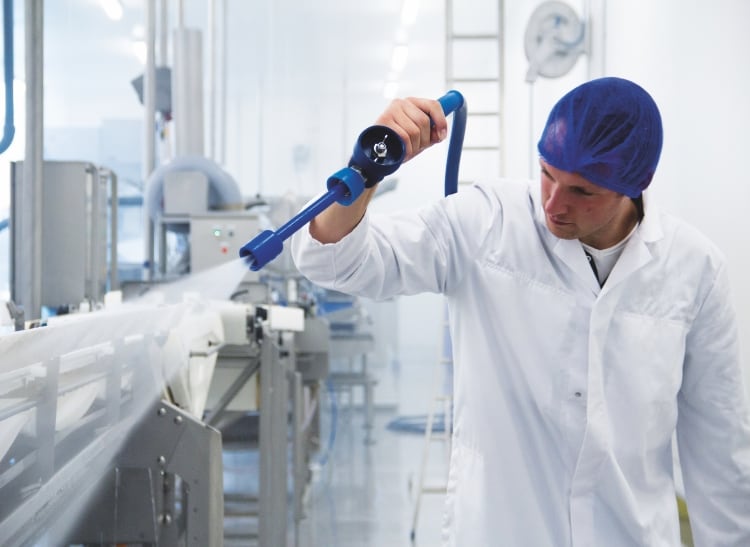According to the Provision Trade Federation (PTF), the current UK cheese market is worth more than £3bn ($4.2bn), with more than 98% of households buying into this category. The average Brit is reported to eat 30g of cheese a day, and there are more than 700 named cheeses produced in the UK, with an export market worth around £675m ($937m).2
Cheese is big business. Across Europe there are many types of cheese, which means a variety of production methods, processes, and hygiene-related challenges to ensure the safety and quality of the product is not compromised.
Generally, cheeses come in varieties including blue, hard, pasta filata, processed, semi-hard, semi-soft, soft, and fresh, and soft-ripened, although regional variations mean that there may be many more to add to this.
Quality and safety issues are a major cause of concern across all sectors of the cheese industry. Irrespective of the type of cheese being produced, the presence of pathogens can present a hazard to vulnerable consumers whilst spoilage organisms will reduce the shelf-life and effect the organoleptic qualities of the product.
For these reasons, micro-organisms must be eliminated or kept to a minimum level through effective cleaning and disinfection regimes.
In addition, “wild” strains, or excessive levels of microorganisms, such as yeasts or molds, can have a detrimental effect on the starter cultures essential to metabolize lactose in the milk into lactic acid, essential in imparting the characteristic flavors in many varieties of cheese.
While microorganisms are often introduced to many varieties of cheese in the form of starter cultures, for example cheddar, or as part of the ripening process, for example Brie, unwanted spoilage microorganisms will result in reduction in shelf life or undesirable organoleptic changes. More seriously for the consumer, pathogenic microorganisms such as the bacterium Listeria monocytogenes, can present a serious health risk in soft cheese varieties, particularly to vulnerable groups.
Pathogenic microorganisms are described as those capable of growing, or surviving in food, and produce illness in the consumer. In cheese, L. monocytogenes is legislated under EU and UK food safety law to be absent at the point at which the product leaves the production site and at less than 100 cfu/g by the end of the product’s shelf-life.

Despite this legal control, many recalls of cheese, predominantly soft varieties, have been issued by EFSA through the RASSF alert system in recent years across many countries including the UK, France, Spain and Italy. Other pathogens that can present a hazard are Staphylococcus aureus, Escherichia coli, Clostridia species and Salmonella enterica although these are less common than L. monocytogenes.
Spoilage microorganism are able to grow in food products, resulting in undesirable changes in their organoleptic properties such as color, flavor or texture. Consequently, these microorganisms affect the shelf life of the product and the consistency of the quality and flavor.
Pseudomonas spp. is the most common spoilage microorganism, whilst molds such as Mucor and Aspergillus sp. can also affect many varieties.
Bacteria can divide their cells every 20 minutes. For this reason, an initial bacterial concentration of 100 cells can be more than 3m after five hours of incubation at optimal temperature!
Therefore, all surfaces over which the product passes must be as hygienic as possible to prevent the transfer of microorganisms.
There are several ways to prevent microorganisms’ multiplication, which are effective pasteurization of milk (unless the cheese is derived from raw milk), cold storage, cleaning and disinfection, personal hygiene, spatial separation of raw and finished product areas and hygiene interventions during the working day.
Biofilm formation also presents a threat to food safety and integrity, particularly as Listeria species are recognized as primary colonizers along with Pseudomonas species. Many foodborne pathogens can develop biofilms in areas difficult to properly clean and disinfect. Their formation depends mainly on the interaction between three components: bacterial cells, adhesion surface and the environment that surrounds the biofilm.
Despite the different varieties, all cheese starts from the same raw material – milk – and production follows six basic steps:
Acidification
Coagulation
Curds and whey
Salting
Shaping
Ripening
Throughout the production process, multiple cleaning and disinfection procedures should be carried out.
CIP, or Cleaning in Place, involves circulating detergent, usually alkaline or acid, through pipework and into vats and tanks via spray-devices. This often highly-automated process requires low-foaming products, specifically formulated to cope with the water chemistry as well as being capable of removing the soil from surfaces.
Where milk has been heated as part of the process, deposits of calcium phosphate will precipitate from the milk and whey. This will agglomerate with fat and protein resulting in milk stone, which require removal using acid detergents or formulated caustic.
Ware washing (Tunnel/Cabinet) items respond well to the use of acid detergents that effectively remove the debris and soiling that may build-up in recesses and corners of the equipment. Often, low foaming products are selected, and the use of an acid detergent minimizes the chances of subsequent product sticking to the surface of the mold.
The manual application of foam detergents, either alkaline or acidic, to the external surfaces of equipment and the inside of open tanks or vessels ensures the effective removal of cheese residue. Commonly, chlorinate alkaline products are used due to their ability to remove protein and fats.
Dismantled, removed or small parts may be cleaned manually in sinks or other suitable receptacles to remove debris and product build-up. Often, a neutral detergent with warm to hot water is used and any brushes or utensils used to achieve the clean should themselves be regularly and thoroughly cleaned to ensure they don’t present a hazard to subsequent cheese products.
It goes without saying the standard of personal hygiene of employees is, as with all food processing, critical to ensure the safety and quality of the cheese produced. Effective hand washing and disinfection using suitable products is crucial, as is the cleaning of clothing worn in the food production area.
One further method of cleaning is aerial disinfection. Depending on the cheese type, cheese factories are sensitive to fungal yeasts and molds contaminations and aerial disinfection is an essential step in minimizing this risk.
Membrane cleaning is a highly-specialized task using specifically-formulated products. Primarily, this is because this process helps turn waste products into high-value end-products, which are sought after in other food-processing industries as ingredients or raw materials.
The most common techniques used for protein standardization are microfiltration, which removes bacteria from cheese milk and can be used to achieve sanitation of the brine solution; and ultrafiltration, which concentrates whey protein that can then be utilized in other products or processes; and reverse osmosis which also concentrates whey proteins.
It is also imperative the cleaning and disinfection of cheese molds is effective. Poor cleaning can cause blocked draining pores, which will affect yield and product quality.
In this important sector of food production, the effective application of hygiene controls ensures end products can continue to be enjoyed safely. The standard of hygiene and the efficacy of the cleaning and disinfection regime employed, however, must be monitored, managed, and suitably documented to provide customers and food safety authorities with the confidence the process is under full control and all risks have been considered.
Part of this management process is to employ suitably-trained staff equipped with the tools, time and chemical regimes designed to minimize risk and maximize product quality and safety.
As cheese is a ready-to-eat food, specific hygiene legislation requires the control of pathogenic microorganisms such as L. monocytogenes to avoid food poisoning and product recalls. A well designed, managed, and equipped food-safety management system will ensure this aim is met, and that hygiene will be subject to a process of continuous improvement.
Christeyns Food Hygiene has more than 30 years of experience in the cheese hygiene business and provide both chemicals and equipment for customers on a bespoke basis.
Sources:
1. Statista Annual Volume of cheese produced in the UK - https://www.statista.com/statistics/616651/production-volume-of-cheese-united-kingdom-uk/)
2. NFU Countryside

